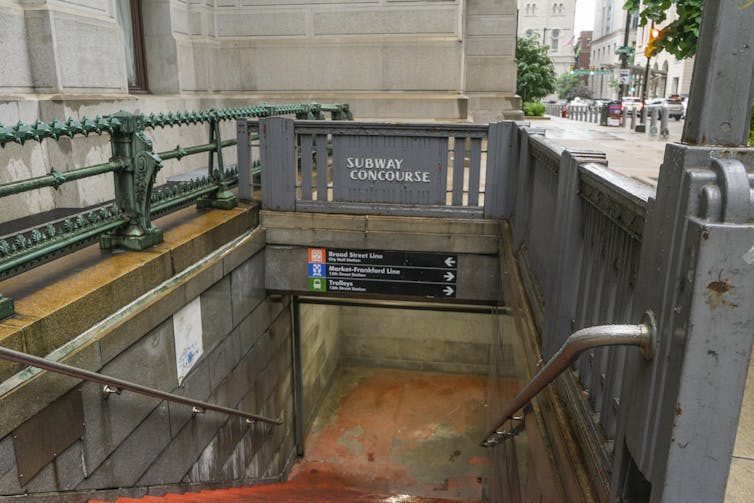The air quality in the City Hall subway station in downtown Philadelphia is much worse than on the sidewalks directly above the station. That is a key finding of our new study published in the Journal of Exposure Science & Environmental Epidemiology.
We are an environmental scientist and a biochemist who assessed the air quality at the 15th Street-City Hall station in Philadelphia. We focused on this station because our previous study found it to have the highest levels of particulate matter among 12 Philly subway stations we measured on the busy Market-Frankford or Broad Street lines.
Most concerning, we found that there was about 10 times more black carbon inside the station than at street level. Black carbon, which is commonly called soot, is a major component of fine particulate air pollution. It is emitted from incomplete combustion of fossil fuels and biomass burning, and inhaling it is associated with adverse health effects such as asthma, heart attacks and lung cancer.
Our findings suggest that the black carbon is being generated by the subway system itself. Graphite used on brake pads is one potential source.
We also found that levels of ultrafine particles, or UFP, were about 1.7 times higher underground than above ground. While fine particles are up to 2.5 microns in diameter – about 35 times smaller than a grain of fine beach sand – ultrafine particles are 0.1 microns or smaller. These particles are concerning, as they penetrate deep into people’s lungs.
Limited access to outside air, the frequency of trains, a large number of passengers and its location in the heart of Center City may be some of the reasons for the high concentrations of particulate matter at the 15th Street station.
Subway air quality has previously been investigated in Philadelphia and several other U.S. cities, including Boston, New York City and Washington, D.C. A study of 71 subway stations in those metro areas found PATH stations in New York and New Jersey to have the highest concentration of fine particles. That study also found a similar concentration of fine particles, mainly iron and carbon, in Philadelphia as we found.
Our study, however, measured more types and sizes of particulate matter.

Ventilation, cleaning could help curb the pollution
Our study highlights the need for Philadelphia to monitor the air quality in its subways and to reduce air pollution exposure for commuters and subway workers.
Several major factors contribute to subway air pollution. These include the subway system’s age, how worn the wheels and rails are, the frequency of trains, the use of a graphite lubricant on the brake pads, poor ventilation, station depth and the limits of access to outdoor air and outdoor traffic.
Having better ventilation, using platform screen doors and cleaning more often to minimize dust are a few ways to improve air quality.
While we believe air quality in the subway needs to be improved, our findings do not suggest that commuters should avoid taking the subway. Air pollution levels are highly variable across stations and over time, and commuters spend relatively short periods of time inside subway stations.
People with any health concerns, especially a lung condition, can get excellent protection by wearing an N95 mask or even a surgical mask. Subway workers can use air purifiers to reduce their exposure to particle pollution.
We simultaneously measured the particle pollution in the underground subway platform and the pedestrian pathway above ground using three types of monitors. We took measurements for six hours a day, from about 9 a.m. to 3 p.m., on five weekdays during the summer of 2022.
Next up: Test the pollutants on human cells
The next step in this project is to expose lung cells in the lab to the air pollution particles from the 15th Street Station and measure the oxidative stress caused by the particles. This stress contributes to chronic diseases, including asthma, chronic obstructive pulmonary disease and lung cancers.
We will also examine the types of air particles, and the levels of various metals in them, to determine what about these particles from the subway causes stress to lung cells.
Before you go...
Please consider supporting Technical.ly to keep our independent journalism strong. Unlike most business-focused media outlets, we don’t have a paywall. Instead, we count on your personal and organizational support.
Join our growing Slack community
Join 5,000 tech professionals and entrepreneurs in our community Slack today!

The person charged in the UnitedHealthcare CEO shooting had a ton of tech connections

From rejection to innovation: How I built a tool to beat AI hiring algorithms at their own game

Where are the country’s most vibrant tech and startup communities?


